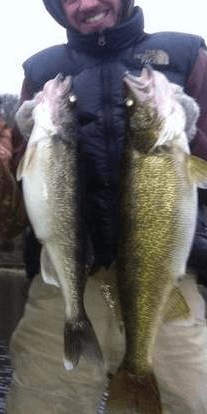Blue walleye
| Blue Walleye (Blue Pike) | |
|---|---|
 | |
| Scientific classification | |
| Kingdom: | Animalia |
| Phylum: | Chordata |
| Class: | Actinopterygii |
| Order: | Perciformes |
| Family: | Percidae |
| Genus: | Sander |
| Species: | S. vitreus |
| Subspecies: | S. v. glaucus |
| Trinomial name | |
| Sander vitreus glaucus (Hubbs, 1926) | |
The blue walleye (Sander vitreus glaucus), also called the blue pike, is a subspecies of the walleye that has been critically endangered in the Great Lakes since the 1980s. Until the middle of the 20th century, it was a commercially valuable fish, with about a half million tonnes being landed from about 1880 to the late 1950s, when the populations collapsed.
The fish was endemic to lakes Erie and Ontario of the Great Lakes region of North America, including the interconnecting Niagara River, but most especially to Lake Erie, where it sometimes represented more than 50% of the commercial catch. The subspecies was apparently extirpated in the Great Lakes by about 1983 through a combination of anthropogenic eutrophication, overfishing and competition with the introduced rainbow smelt, Osmerus mordax. The subspecies is now considered extinct.
There are occasional reports of blue walleye being caught from waters in the Great Lakes Basin, because many yellow walleye populations also contain a bluish colour variant. The actual blue walleye, however, was said to be distinguishable from the yellow walleye by various meristics and morphometrics which the blue colour variant of the yellow walleye seems not to share. Reportedly, though, some of the meristic and morphometric differences may simply have been artifacts of the different growth rates of yellow and blue walleyes. The clearest evidence, however, indicates that the blue walleye, whatever its taxonomic status, has been lost. Nonetheless, an investigation of genetic material from preserved blue walleye specimens is currently underway in several research facilities in an effort to decipher the true status of the populations.


To date, none of the bluish-coloured walleyes recently captured has been shown to be a blue walleye, although at least one organization in the US is offering a reward for successful capture of a blue walleye specimen. A United States Fish and Wildlife Service recovery plan in the mid-1970s was unable to find any certain evidence of the blue walleye's existence at that time. Nine purported blue walleyes captured in 1975 , including a number of gravid females, were inconclusive as to their subspecific designation and failed to produce any viable offspring through artificial propagation. The last known blue walleyes, to any degree of certainty, were captured in about 1983 from lakes Erie and Ontario . Subsequent exhaustive efforts to find a relict population have been entirely unsuccessful. The loss of the blue walleye is, arguably, an extinction event on par with the loss of the passenger pigeon and the near-extirpation of the American bison. Where once the subspecies numbered in the millions, all are now gone.
The blue walleye is in the same family as the yellow perch.
External links
- NatureServe (2013). "Sander vitreus". IUCN Red List of Threatened Species. Version 2013.2. International Union for Conservation of Nature. Retrieved 12 June 2014. Assessment includes information on subspecies S. v. glaucum (sic) conservation status.
- Nativefish.org article about the Blue Pike, archived on 23 July 2008
- Species at risk (Canada) article
- Blue Walleye Research
- O.O.D - A Blue Mystery
- NYTimes In Angler's Freezer Since '62, Fish May Refute 'Extinction'